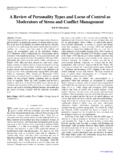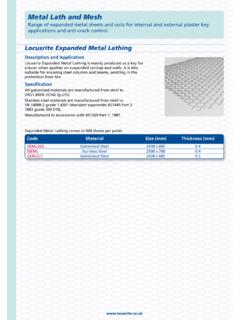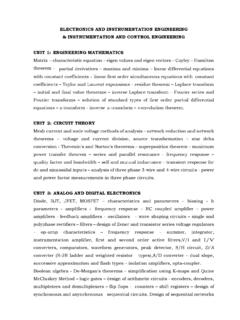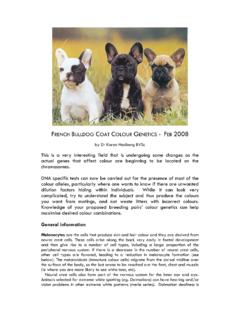Transcription of Panic Disorder and GAD - Columbia University
1 1 Panic Disorder and GADS anjay J. Mathew, Professor of Psychiatry Mount Sinai School of MedicineAdjunct Faculty, Columbia University College of Physicians and SurgeonsLifetime Prevalence of Common Psychiatric DisordersKessler 1994; Kessler 1995; DSM-IV-TR 2000.*In menstruating prevalence (%) stressdisorder (PTSD) anxietydisorder (GAD) (OCD)1618 Alcohol depressive anxiety disorder5%*Premenstrual dysphoricdisorder (PMDD)General Characteristics Generally begin in childhood Interaction of heritable factors and adverse life events Main components:-acute fear: freezing, autonomic signs,glucocorticoid response-contextual fear: phobic avoidance -worry and apprehensionPanic Attack Definition A discrete period of intense fear or discomfort in which 4 (or more) of the following symptoms develop abruptly and reach a peak within 10 minutes.
2 (a)palpitations, pounding heart, or accelerated heart rate(b)sweating(c)trembling or shaking(d)sensations of shortness of breath or smothering(e)feeling of choking(f)chest pain or discomfort(g)nausea or abdominal distress(h)feeling dizzy, unsteady, lightheaded, or faint(i)derealization (feelings of unreality) or depersonalization (being detached from oneself)(j)fear of losing control or going crazy(k)fear of dying(l)paresthesias (numbness or tingling sensations) (m) chills or hot Disorder DSM-IV-TRTM Key features of Panic Disorder with or without agoraphobia Recurrent and unexpected Panic attacksand At least 1 of the attacks has been followed by 1 month (or more) of 1 (or more) of the following.
3 (a) persistent concern about having additional attacks(b) worry about the implications of the attack or its consequences (eg, losing control, having a heart attack, going crazy)(c) a significant change in behavior related to the attacks Panic attacks are not due to effects of a substance or general medical condition Panic attacks are not better accounted for by another psychiatric disorderAgoraphobia DSM-IV-TRTM Anxiety about being in places or situations From which escape might be difficult (or embarrassing) or In which help may not be available in the event of having a Panic attack or Panic -like symptoms, for example Being outside the home alone Being in a crowd or standing in a line Being on a bridge Traveling in a bus, train, or automobile The situations are avoided (eg, travel is restricted) or else are endured with marked distress or with anxiety about having a Panic attack or Panic -like symptoms, or require the presence of a companion The anxiety or phobic avoidance is not better accounted for by another mental disorderDSM-IV-TR2000.
4 2 Limitations of DSM The categorical nosology implies that if you have less than the full criteria for Disorder you have nothing. Diagnostic criteria for some of the anxiety disorders lack a solid empirical base Subthreshold disorders might be as clinically significant as those meeting full DSM criteriaThe Panic -Agoraphobia Spectrum: 8 Key Components Separation sensitivity Panic -like symptoms Stress sensitivity Medication and substance sensitivity Anxious expectation Agoraphobia Illness phobia and hypochondriasis Reassurance orientationSeparation Sensitivity(separation anxiety)In the past month, did you experience a lot of.
5 Because of thoughts that you might lose someone close to you or some harm might come to them (for example, did you worry a lot if your family members or close friends argued, or they did risky things or had an illness)? Did you have trouble going to sleep without someone nearby or trouble sleeping away from home?Separation Sensitivity(loss sensitivity) Did you stay in a relationship even when it was not in your best interest, rather than risk being alone? What about pets? Are you the type of person who gets very attached to your pets and gets very upset if the pet dies or is lost? Panic -Like Symptoms(atypical symptoms)Have you ever.
6 Disoriented, as if you have lost your bearings? ..that you were about to lose control of your behavior? ..nervous, uncomfortable, or as though you were about to suffocate, because of hot, stale or humid air, or because of perfume, or other smells, even if they weren t that strong?Substance and Medication SensitivityDid you ever experience Panic -like symptoms when you ..coffee, tea, or other caffeinated beverages? ..cold medicine, nasal sprays, thyroid, sleep, or antidepressantmedications?Have you ever been afraid of or did you ever ..taking prescribed medications because you thought they might harm you or that you were overly sensitive to side effectsor allergic ?
7 Do you read the package insert more carefully than most other people because of feeling nervous or uncomfortable about taking medication?3 Agoraphobia(atypical)In the past month, did you avoid, feel nervous or ..wearing high-necked shirts, ties, or tight fitting clothes because they made you feel trapped? ..being physically intimate because you felt trapped? ..going to places where you were not sure there was a bathroom available? Panic Disorder Epidemiology Age at onset: typically 15-34 years Women are at least twice as likely to be affected Prevalence of Panic Disorder among patients in cardiology clinics: as high as 60% 10% to 30% prevalence among patients in vestibular, respiratory, or neurology clinics Very rare in elderly DSM-IV-TR 2000.
8 Sadock and Sadock Circuitry: a Context forPathophysiology of Anxiety Research on fear in animals has identified specific circuits involved in fear conditioning Amygdala: acquisition, storage, expression, and extinction of fear memory Hippocampus: contextual control of fear Medial PFC: regulation of fear by changes in environmental circumstances Stress-induced alterations in fear circuits may contribute to the development and/or maintenance of pathologic fearHippocampusMedial Prefrontal Cortex, CingulateGorman et al: Am J Psychiatry 157, 2000 Amygdala Lateral NucleusBasalCentral Nucleus of the AmygdalaHippocampusHypothalamusParaventr icular NucleusLateral NucleusMedial Prefrontal Cortex, CingulateAdrenal GlandsInsulaAssociation BundlePituitarySensory ThalamusLocus CeruleusPeriaqueductal Gray RegionVisceral AfferentsGorman et al: Am J Psychiatry 157, 2000 Nucleus of the Solitary TractAmygdala Lateral NucleusBasalCentral Nucleus of the AmygdalaAutonomic PathwaysParabrachial NucleusLimitations of Conditioned Fear as Model of Panic Disorder It is unclear what is being conditioned in Panic Disorder , as attacks typically occur out of the blue.
9 Fear might not be equivalent to Panic and/or anxiety Not clear that the Panic Disorder is associated with elevations in cortisol and HPA axis overactivity Anti- Panic treatments do not blunt ability to mount appropriate fear responses4 NOREPINEPHRINELOCUS CERULEUS/Metabolite - MHPG/PONSNOREPINEPHRINE/ LOCUS CERULEUS SYSTEM. IAFFERENT SYSTEMSNE5-HTGABAGLUTAMATEACETYL-CHOLINE - Inhibitory- Stimulatory -2 Adrenoceptor=Auto-receptorCRFA drenergic receptor polymorphismsSmall et al, 2002, NEJMS erotonin Receptors5-HTtransporterSSRIs5-HT1A5-HT5 -HT1B/D5-HT1A5-HT1D5-HT1D5-HT2C5-HT2A5-H T35-HT5-HT Transporter Genetic Variation andAmygdalar Activity Regulation of 5-HT synapses depends in part of 5-HT reuptake, which is mediated by the serotonin transporter (5-HTT).
10 Anxiety traits have been linked to alterations in 5-HTT genes the short allele of the 5-HTT promoter polymorphismis associated with reduced 5-HTT expression and function and increased fear and anxiety-related behaviors fMRI has been used as an endophenotypic assay to evaluate whether brain activity response of amygdala to fearful faces was associated with variation in the 5-HTT S/L polymorphismAB(Hariri et al., 2002, Science)Emotion taskSensorimotor controlAmygdala Response: s Group > I Group54321 First Cohort(N = 14)Second Cohort(N = 14)T Value(Hariri et al., 2002, Science)BOLD fMRI5 Gray matter volume reductions of s allele carriers compared to l/l genotype (n=114)

















